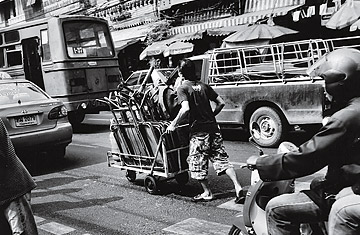
Cyclists and motorist on the streets of Bangkok, Thailand circa March, 2008.
As a Bangkok traffic policeman, Phichet Wisetchoke carries the usual tools of his trade: a baton, a sheaf of tickets, a mask to repel smog--and a tiny umbilical-cord clamp. Traffic in Thailand's capital snarls with such ferocity that hundreds of women over the past few years have been forced to give birth in cars. So the Royal Thai Traffic Police has trained 145 of its officers in basic midwifery. Phichet, who carries bundles of gauze and an aspirator to clear newborns' noses, has delivered nine babies in traffic--two in February alone. "I wanted to be a policeman because I thought it would be fun to catch bad guys," says Phichet, who has no children of his own. "But this is Bangkok, and the traffic is so bad, I have an even better job: bringing babies into the world."
And what a gridlocked world that is. Bangkok trumps Mexico City, Los Angeles and other megacities in its capacity to come to a standstill. Police don't consider traffic bad until a car is stationary for at least an hour. Really bad is two hours.
Some 5.7 million vehicles inch through Thailand's capital: trucks, tractors, buses, motorcycles, sedans, auto rickshaws and the occasional elephant. As an increasing number of Thais announce their arrival in the middle class with a gleaming new car, more than 2,000 vehicles are added to Bangkok's roads each day. Yet only 4.4% of Bangkok's total area is paved, compared with 20% of many U.S. cities. Bangkok's city planners have tried to alleviate traffic with a public-rail network, but the subway and elevated Skytrain are sorely inadequate. The Skytrain, for instance, covers only downtown Bangkok and doesn't take commuters to the city center; an extension originally scheduled to open in 2002 still hasn't been finished. Each day, only 700,000 trips are made on Bangkok's rail system, compared with 6.5 million on public buses and 10 million in private vehicles. "Even if we build 100 more roads, it still won't be nearly enough," says Pharnu Kerdlarpphon, deputy commissioner of the Bangkok Metropolitan Police. "We need a complete overhaul of Bangkok's transportation system, but there's no sign of that happening anytime soon."
How did this metropolitan area of 10 million grind to a halt? Just a few decades ago, the Thai capital was a tropical outpost crisscrossed by canals and surrounded by rice paddies. By the 1970s, the city began to boom, in part because of an influx of American soldiers seeking R. and R. from the Vietnam War. Even back in 1972, with only 243,000 cars on the streets, Bangkok had trouble coping with all the new Buicks and Toyotas. As a stopgap solution, local planners paved over city canals. The result is a haphazard road network on which the average car spends the equivalent of nearly 45 days a year stuck in traffic. Even worse, the declining number of canals, which once served as reservoirs for rain, means that substantial portions of the city flood during the five-month-long wet season. The rising water invariably short-circuits traffic lights, turning intersections into free-for-alls.
The omnipresent traffic has changed the way Bangkok residents live--and wards off some foreign investors. To avoid the worst congestion, kids are often bundled into cars before dawn while they're still asleep. They arrive at school sometimes hours before the bell rings and eat breakfast and brush their teeth, all while parked meters from their school. Vendors tempt idled commuters with everything from doughnuts and cell-phone-card refills to garlands of jasmine--sometimes used as offerings to the gods of traffic. More than $1 billion in productivity is lost every year to traffic jams. No surprise, then, that while reporting this story, I was late by nearly an hour to every interview because of traffic.
Late arrivals aside, most locals are remarkably sanguine about the gridlock. Road rage rarely erupts, perhaps because of a Buddhist equanimity that helps keep tempers in check. Packs of stray dogs have learned to nap between stopped cars on roadways that were ambitiously designed to accommodate 90 km/h (56 m.p.h.) travel. (The average pace during the morning rush hour is 15 km/h, or 9 m.p.h.) The only group that has admitted to feeling the pressure is traffic policemen. Last December, 1,200 of the city's 4,000 traffic cops participated in a therapy program called Let's Come Together and Laugh to Help Our Mental and Physical Health. Stress-relieving treatments included various smiling exercises, from teeth-baring grins to out-and-out guffaws. "Most other countries have fancy equipment to help with traffic," says deputy police commissioner Pharnu. "All we have is laughter."